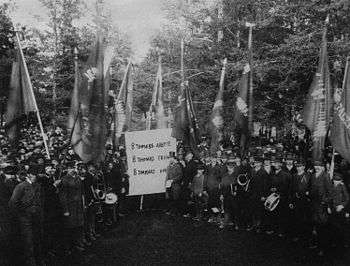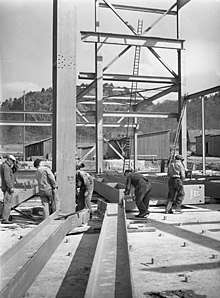Swedish labour movement
The labour movement in Sweden dates back to at least the 1850s, when Swedish workers initiated the organizing of previously spontaneous food riots into strikes, hence acting as an autonomous group.[1]


History
Modern types of labour unions emerged in the 1870s. An event that is usually considered to be central in the early days of the Swedish labour movement is the lecture "Hvad vil Social-Demokraterna?" ("What do the Social Democrats want?") by August Palm, at Hotel Stockholm in Malmö 6 November 1881. Five years later, in 1886, Sweden's first national labour union, Svenska Typografförbundet, was founded.[2] Another union of that sort, Svenska Postmannaförbundet, was founded later that same year.[3]
The labour movement soon divided into two parts, a political one and an unionspecialized one. The union movement was organized in one central organization, the Swedish Trade Union Confederation (LO), founded in 1898, with the aim to organize all national labour unions in one central organization. Parallel to, but closely associated with this movement is the Swedish Social Democratic Party (SAP), founded in 1889.[4]
These two organizations has ever since dominated not only the Swedish labour movement but also the political life in general. One example of their close association is the fact that all members of LO was initially automatically made members of SAP.[5]
Even though LO has dominated labour relations in Sweden, the two other big confederations for unions, the Swedish Confederation of Professional Employees, TCO, and the Swedish Confederation of Professional Associations, SACO, are today almost as important participants as LO in the debate of labour economics. In 2008 for the first time the total number of active wage and salary members (i.e. excluding pensioner, students and self-employed) in TCO and SACO together surpassed that of LO.[6] In the year before that (2007), the center-right government considerably raised the fees to unemployment funds, which in particular hit funds run by LO unions. The result was large membership losses of LO funds and LO unions and rapidly declining union density.[7] The declining number of LO members is also related to the decreasing share of blue-collar workers in the labour force.
References
Printed sources
- Olsson, Lars; Ekdahl, Lars (2002). Klass i rörelse: arbetarrörelsen i svensk samhällsutveckling. Arbetarhistoria, 0281-7446 ; 2002:1/2[Årsbok / Arbetarnas kulturhistoriska sällskap], 1400-3392 ; [2002] (in Swedish). Stockholm: Arbetarrörelsens arkiv och bibl. ISBN 91-973690-3-9.
- Nycander, Svante (2008). Makten över arbetsmarknaden: ett perspektiv på Sveriges 1900-tal (in Swedish) (2nd ed.). Stockholm: SNS Förlag. ISBN 9789185695652.
Notes
- Olsson & Ekdahl (2002), p. 13
- Björklund & Edin & Holmlund & Wadensjö (1996), p. 245.
- Nycander (2002), p. 18
- Olsson & Ekdahl (2002), p. 24
- Olsson & Ekdahl (2002), p. 24
- Per 31 December. See Anders Kjellberg (2020) Kollektivavtalens täckningsgrad samt organisationsgraden hos arbetsgivarförbund och fackförbund, Department of Sociology, Lund University. Studies in Social Policy, Industrial Relations, Working Life and Mobility. Research Reports 2020:1, Appendix 3 (in English) Table A, Appendix 4 Tables 39-40
- Anders Kjellberg (2011) "The Decline in Swedish Union Density since 2007" Nordic Journal of Working Life Studies (NJWLS) Vol. 1. No 1 (August 2011), pp. 67-93
Further reading
- Anders Kjellberg (2017) The Membership Development of Swedish Trade Unions and Union Confederations Since the End of the Nineteenth Century (Studies in Social Policy, Industrial Relations, Working Life and Mobility). Research Reports 2017:2 (updated 2020). Lund: Department of Sociology, Lund University
